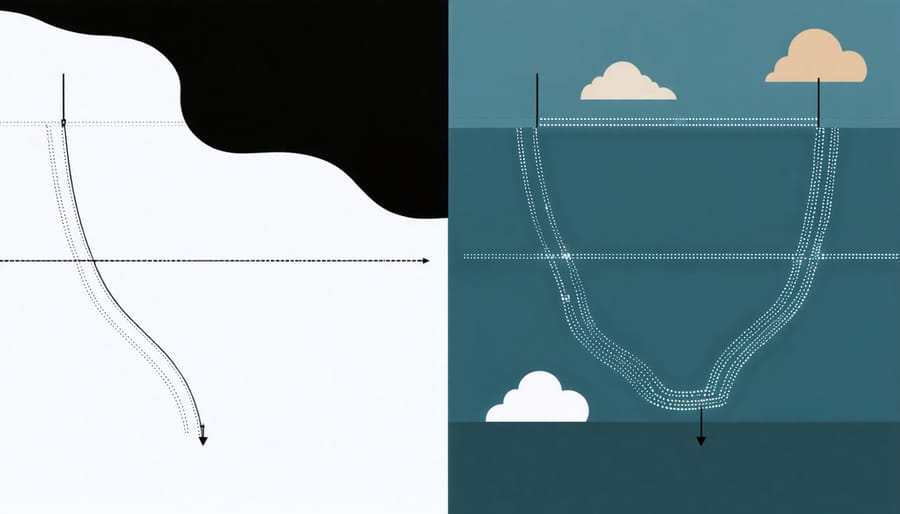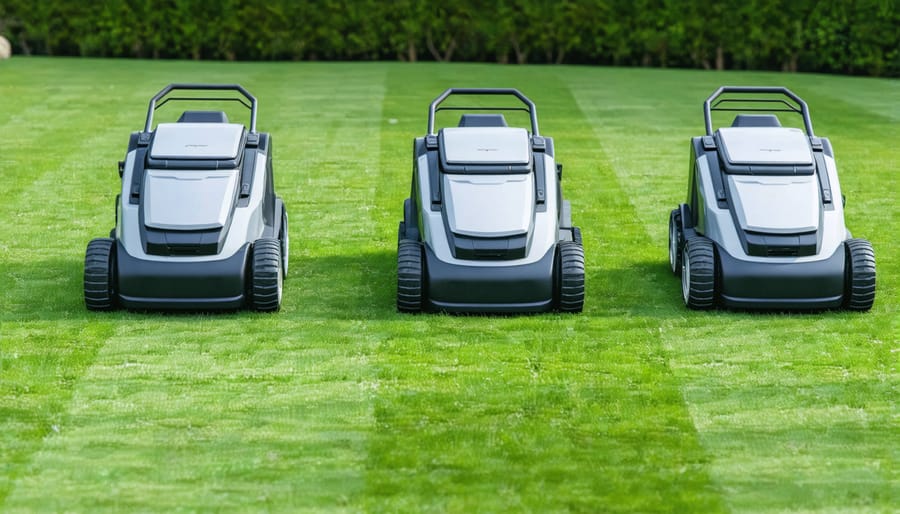GPS-enabled robotic lawn mowers represent a revolutionary leap in lawn care automation, combining satellite precision with intelligent navigation to transform how we maintain our yards. These smart machines use advanced positioning systems to create detailed maps of your property, navigate complex landscapes with pinpoint accuracy, and maintain perfect cutting patterns without human intervention. Unlike traditional robotic mowers that rely solely on boundary wires, GPS-equipped models offer enhanced efficiency, reduced maintenance requirements, and superior coverage accuracy – often achieving up to 30% faster mowing times. Whether you’re managing a compact suburban lawn or extensive property grounds, GPS technology ensures your robotic mower operates with unprecedented precision, adapting to obstacles, weather conditions, and varying terrain while maintaining consistent cutting quality. This introduction to GPS-enabled mowing solutions will explore how this technology works, its practical benefits for homeowners, and what to consider when upgrading your lawn care system to include satellite navigation capabilities.
How GPS Navigation Transforms Robotic Lawn Care
Precise Boundary Mapping
Gone are the days of burying boundary wires in your lawn! GPS-enabled robotic mowers use satellite technology to create virtual boundaries with impressive accuracy. By walking the perimeter of your lawn with the mower or using a smartphone app, you can define precise cutting zones that your robotic helper will faithfully follow.
The system works by creating a digital map of your property, typically accurate within 2-4 centimeters. This virtual fence tells your mower exactly where to cut and, more importantly, where not to. You can easily mark off garden beds, paths, or other areas you want the mower to avoid, all without physical barriers.
What’s particularly convenient is the ability to create multiple zones within your yard. Maybe you want the mower to handle your front and back lawns differently, or perhaps you need to section off a play area. With GPS mapping, you can customize these zones with just a few taps on your phone.
The best part? These boundaries stay put even after power outages or battery changes, making the system incredibly reliable and maintenance-free.

Efficient Mowing Patterns
GPS technology enables robotic lawn mowers to create highly efficient cutting patterns that ensure complete lawn coverage while minimizing redundant passes. Rather than moving in random patterns, GPS-guided mowers map your yard and develop systematic routes that cover every inch of grass in the most time-efficient manner.
These smart devices typically start by mowing along the perimeter of your lawn, then work their way inward using parallel lines or spiral patterns. This methodical approach, combined with robotic mower scheduling, ensures consistent cutting height and reduces wear on your lawn.
The mower’s GPS system continuously tracks its position, allowing it to remember where it has already cut and which areas still need attention. If the mower needs to recharge, it can return exactly where it left off to complete the job. This intelligent navigation also helps the mower adapt to obstacles and narrow passages, adjusting its path accordingly while maintaining optimal coverage.
For oddly shaped yards or areas with multiple zones, GPS-guided patterns are particularly valuable as they can efficiently navigate complex layouts without missing spots or getting stuck.

Real Benefits of GPS-Enabled Mowers
Time and Energy Savings
One of the most compelling advantages of GPS-enabled robotic lawn mowers is their remarkable efficiency in both time and energy management. Our detailed cost and time savings analysis shows that homeowners can reclaim up to 4-6 hours of their weekend time each month during the growing season.
These smart mowers optimize their cutting patterns using GPS navigation, reducing overlap and unnecessary passes across your lawn. This systematic approach typically results in 20-30% faster mowing times compared to traditional robotic mowers without GPS capabilities. The precision routing also means less energy consumption – most GPS-enabled models use about 30% less electricity than their non-GPS counterparts.
What’s particularly impressive is how these mowers adapt their charging patterns to your lawn’s specific needs. They’ll return to their charging station when necessary and resume exactly where they left off, eliminating wasted energy from random navigation. Many models even adjust their mowing schedule based on grass growth rates and weather conditions, ensuring they’re only operating when truly needed.
For busy homeowners, this means your lawn stays perfectly maintained without any hands-on effort. The mower works efficiently in the background, often during off-peak electricity hours, while you focus on more important activities. Plus, the reduced energy consumption translates to lower electricity bills and a smaller environmental footprint.
Enhanced Security Features
Today’s robotic lawn mowers come equipped with sophisticated security features that give you peace of mind while your mower works independently. GPS tracking stands at the forefront of these security measures, acting as both a theft deterrent and recovery tool. If someone attempts to steal your mower, you’ll receive an instant alert on your smartphone, and you can track its location in real-time through a dedicated app.
Geofencing adds another layer of protection by creating virtual boundaries for your mower. You can set up precise perimeters around your lawn, and if the mower moves outside these designated areas, it automatically shuts down and sends you a notification. Some models even include PIN codes and alarm systems that activate when the mower is lifted or tilted unexpectedly.
Many GPS-enabled mowers also feature smart theft protection that renders the machine unusable when taken outside its designated working area. Some advanced models incorporate cellular connectivity, enabling constant communication with your smartphone even if the mower is transported far from your property.
For added security, consider registering your mower’s serial number with the manufacturer and keeping documentation of your purchase. Most GPS-enabled models also store usage history and location data, which can be valuable information for law enforcement if theft occurs.
Setting Up Your GPS Robotic Mower

Initial Setup Steps
Getting your GPS-enabled robotic mower up and running is easier than you might think. Let’s walk through the essential setup steps to ensure your new lawn companion works perfectly from day one.
First, identify the ideal location for your charging station. Choose a flat, level surface near a power outlet, preferably in a shaded area to protect the electronics. Make sure there’s at least 6 feet of straight path in front of the station for smooth docking.
Next, install the boundary wire around your lawn’s perimeter. This wire works in conjunction with the GPS system to create precise mapping. Lay the wire about 4-6 inches from lawn edges and secure it with pegs every 30 inches. Pay special attention to corners, making gentle curves rather than sharp angles.
Now, power up your mower and follow the manufacturer’s app installation instructions on your smartphone. Most modern GPS mowers use dedicated apps for setup and control. During the initial startup, allow your mower to complete a full boundary wire scan – this usually takes 30-45 minutes.
After the boundary scan, the mower needs to establish its GPS coordinates. Leave it running in an open area for about 15-20 minutes to acquire a strong satellite signal. This process creates your lawn’s digital map, which the mower will refine over subsequent mowing sessions.
Finally, set your preferred mowing schedule and cutting height through the app. Start with a conservative cutting height and adjust as needed. Remember that GPS coverage might vary depending on weather conditions and satellite positions, so give your mower time to learn your lawn’s unique characteristics.
Optimizing Performance
To get the most out of your GPS-enabled robotic mower, proper setup and maintenance are essential for optimal performance capabilities. Start by ensuring your GPS receiver has a clear view of the sky – trim back any overhanging branches or relocate tall obstacles that might block satellite signals. For best results, set up your charging station in an open area away from buildings or dense tree coverage.
Regular calibration is key to maintaining accuracy. Most GPS mowers need a quick calibration run around the perimeter of your lawn before their first use. This helps the mower create a precise map of your property and establish reliable navigation points. Consider running this calibration during clear weather conditions for the most accurate results.
To maximize efficiency, divide larger lawns into zones and program specific mowing patterns for each area. This approach helps your mower navigate more systematically and reduces battery consumption. Speaking of batteries, keep them well-maintained and charged – cold weather can affect battery performance, so adjust your mowing schedule accordingly during winter months.
For enhanced precision, many modern GPS mowers can work with RTK (Real-Time Kinematic) base stations. While this addition requires extra investment, it can improve accuracy from meters to centimeters. If you’re dealing with complex landscaping or want ultra-precise edges, this upgrade might be worth considering.
Don’t forget to regularly update your mower’s firmware. Manufacturers often release updates that improve GPS functionality and overall performance. Also, clean the GPS sensors periodically to prevent dirt and debris from interfering with signal reception.
GPS-enabled robotic lawn mowers represent a significant leap forward in smart gardening technology. These innovative machines not only deliver precise, efficient lawn care but also offer impressive long-term reliability. As GPS technology continues to evolve, we can expect even more advanced features, improved navigation accuracy, and enhanced garden mapping capabilities. For homeowners seeking a hands-free lawn maintenance solution, GPS robotic mowers offer an excellent investment that combines convenience with cutting-edge technology. Whether you have a small suburban yard or a sprawling estate, these smart mowers are transforming the way we care for our lawns, making pristine garden maintenance more accessible than ever before. The future of lawn care is here, and it’s smarter, more efficient, and remarkably user-friendly.
